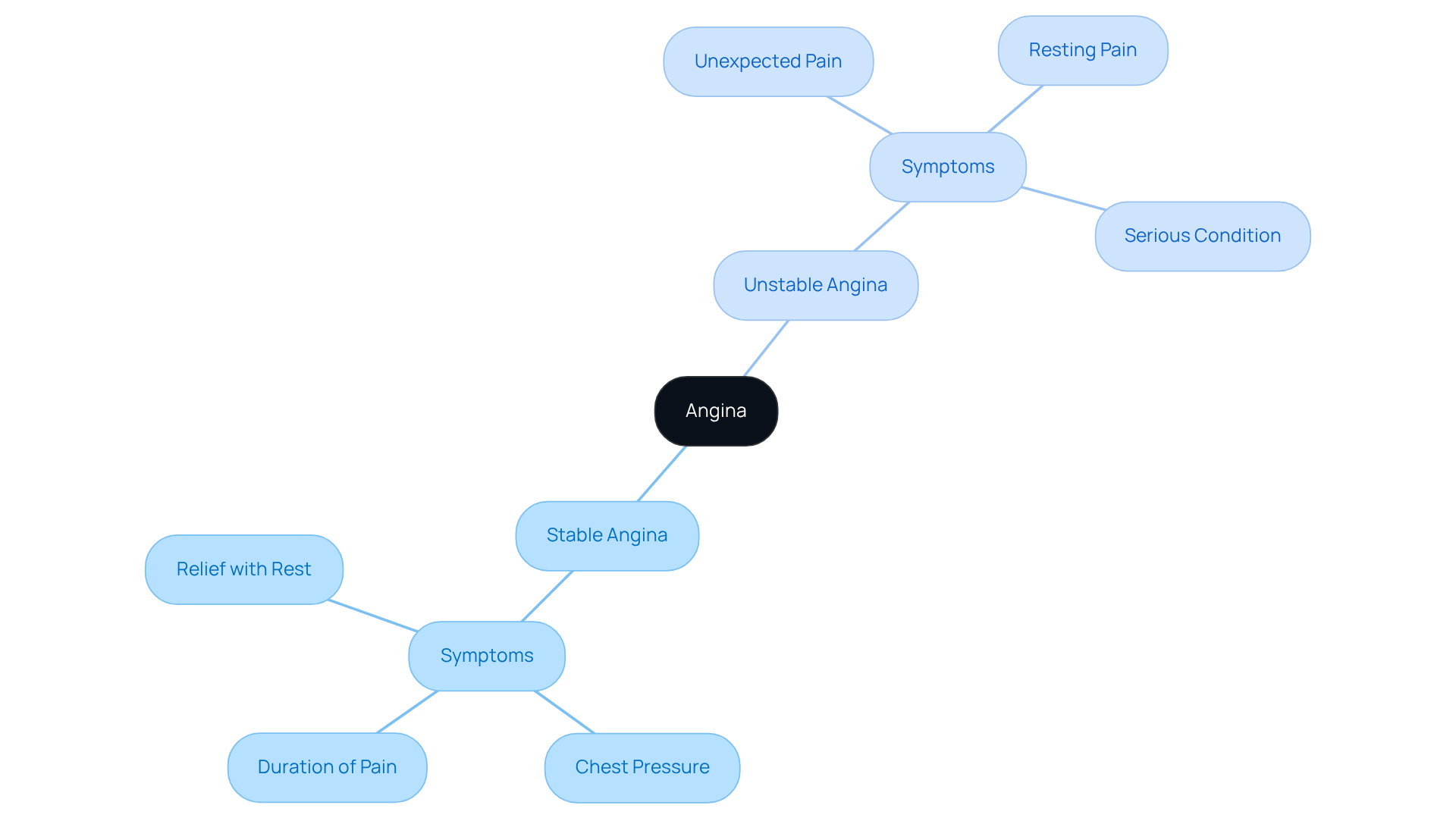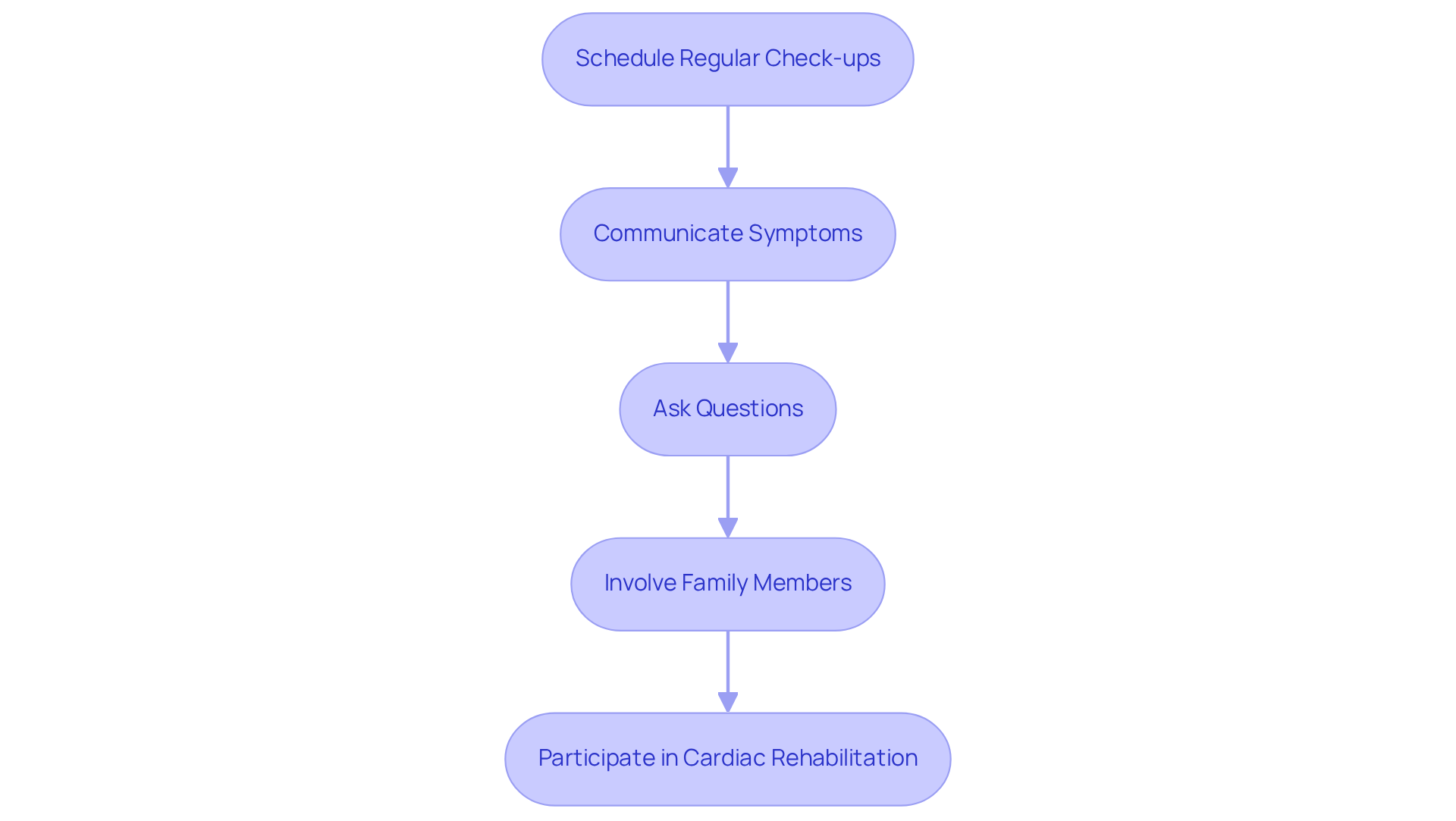


This article emphasizes essential strategies for elderly patients to manage angina through self-care with compassion and understanding. Recognizing symptoms is a vital first step, as it empowers patients to take charge of their health. In addition to this, implementing lifestyle changes—such as adopting a heart-healthy diet and engaging in regular exercise—can significantly enhance well-being.
Furthermore, utilizing prescribed medications effectively and maintaining open communication with healthcare providers are crucial components of managing chest pain and improving quality of life. Remember, you are not alone in this journey; support is available to help you navigate these challenges.
Understanding angina is essential, particularly for older adults, as chest pain can present itself in various ways, often leading to confusion and misdiagnosis. This article explores vital self-care strategies that empower seniors to manage their condition effectively, from recognizing symptoms to making lifestyle changes.
Yet, a significant challenge persists: how can elderly patients navigate the complexities of angina management while ensuring they receive the necessary support? Reflecting on this question highlights not only the importance of informed self-care but also the crucial role of healthcare provider engagement in enhancing quality of life. Together, we can foster a supportive environment that encourages proactive health management.
Chest pain, a type of discomfort that can arise from decreased blood flow to the heart, is categorized into two main forms: stable and unstable. Stable chest pain typically occurs during physical exertion or emotional stress, but it can be relieved with rest or medication. Patients often describe this sensation as pressure, squeezing, or heaviness in the chest, lasting anywhere from 2 to 10 minutes. On the other hand, unstable chest pain may strike unexpectedly, even at rest, and can signal a more serious condition that requires immediate medical attention.
For older individuals, the experience of chest pain is particularly noteworthy, with stable forms being more common. However, many elderly patients might face atypical symptoms, such as shortness of breath, excessive fatigue, or discomfort resembling indigestion, which can complicate diagnosis and management. Importantly, angina can manifest even without significant coronary blockages, leading to potential misunderstandings about its implications. This situation is concerning, as coronary artery disease can limit daily activities and heighten the risk of cardiac arrest.
Understanding these variations is vital for effective angina self-care. Cardiologists at Amavita emphasize the importance of recognizing both typical and atypical signs to ensure timely intervention. Our specialists are dedicated to using advanced diagnostic imaging to identify blockages and offer minimally invasive procedures, like cardiac catheterization and stent placement, to restore blood flow. As one expert thoughtfully remarked, 'A thorough medical history is essential for diagnosing chest pain, often requiring objective tests for confirmation.' This highlights the necessity for elderly patients to remain vigilant about their symptoms and to communicate openly with their healthcare providers to manage their heart health effectively.
Additionally, it is essential to consider the impact of arrhythmias, which can lead to palpitations and fatigue, in relation to chest pain. This underscores the importance of being aware and proactive in managing one’s health. Remember, you are not alone in this journey; seeking help and support is a crucial step towards maintaining your heart health.

Making lifestyle adjustments can greatly improve angina self-care and control of chest pain in older adults. It's important to explore some key strategies that can help you feel better and live a healthier life.
Diet: Embracing a heart-healthy diet rich in fruits, vegetables, whole grains, and lean proteins is a wonderful step. By minimizing saturated fats, trans fats, and sodium, you not only aid in weight management but also help regulate cholesterol levels, which is crucial for your heart health. For example, the Mediterranean diet has shown a remarkable 30% decrease in myocardial infarction and stroke among its followers, making it a favorable option for seniors with heart concerns. As Erin D Michos from Johns Hopkins highlights, understanding the impact of various diets on cardiovascular health is essential for guiding your prevention efforts.
Exercise: Regular physical activity is vital for managing chest pain. Aim for at least 150 minutes of moderate exercise each week, like walking or swimming, tailored to your individual capabilities. Engaging in physical activity can enhance your exercise capacity and reduce discomfort, reinforcing its role in effectively managing chest pain.
Smoking Cessation: Quitting smoking is one of the most significant changes you can make to improve your cardiovascular wellness and alleviate chest pain symptoms. By stopping smoking, you can significantly reduce cardiovascular risks and enhance your overall health.
Stress Management: Techniques such as yoga, meditation, and deep-breathing exercises can be incredibly effective in managing stress, which is a known trigger for chest pain episodes. Incorporating these practices into your daily routine can lead to improved emotional and physical well-being.
Weight Management: Maintaining a healthy weight is essential for reducing strain on your heart and enhancing cardiovascular health. A balanced diet combined with regular exercise can help you reach and maintain a healthy weight, further alleviating symptoms of chest pain.
By embracing these lifestyle modifications, you can take proactive steps towards angina self-care, effectively managing your condition and ultimately improving your quality of life. For instance, a study on the effects of lifestyle changes in older adults with chest pain demonstrated notable enhancements in their overall well-being and a decrease in episodes of discomfort, emphasizing the real benefits of these approaches. Remember, you are not alone in this journey, and seeking support can make a significant difference.

Medications play a crucial role in managing chest pain, especially for older adults who may feel anxious about their health. Understanding the options can help provide some peace of mind. Here are some key medications that can offer relief:
Nitrates: Medications such as nitroglycerin are vital for quick relief during angina attacks. By relaxing blood vessels, nitrates improve blood flow to the heart, effectively easing chest pain. They come in various forms—sublingual tablets, patches, and sprays—offering flexibility in treatment. However, it's important to note that tolerance can develop quickly, so patients should have nitrate-free intervals to ensure continued effectiveness. Their long-standing use since the 1800s attests to their reliability in managing chest pain.
Beta-blockers: These medications, including metoprolol and carvedilol, help decrease the heart's workload and lower blood pressure, which can prevent episodes of chest pain. They are particularly beneficial for elderly individuals, significantly reducing the risk of cardiovascular incidents. Cardiologists often recommend beta-blockers as the primary treatment for managing chest pain in this age group due to their proven efficacy. While typical side effects may include dizziness and fatigue, discussing these with healthcare providers can help address any concerns.
Calcium channel blockers: These medications work by relaxing and widening blood vessels, enhancing blood flow and alleviating angina symptoms. They serve as a valuable second-line option for patients who may not tolerate beta-blockers well.
Antiplatelet agents: Medications like aspirin are essential in preventing blood clots, thereby lowering the risk of cardiac events. This is particularly important for older adults with a history of cardiovascular issues, as it can significantly impact their health.
Statins: These medications help reduce cholesterol levels and stabilize arterial plaque, further decreasing the risk of chest pain and heart attacks.
Following prescribed medication plans is crucial for effective management of chest pain. It’s important for patients to maintain open communication with their healthcare providers about any side effects or concerns, ensuring their treatment plan is tailored to their health needs. Additionally, remember that nitrates should not be combined with certain medications, such as phosphodiesterase inhibitors, due to the risk of severe hypotension. By staying informed and engaged with your healthcare team, you can take proactive steps towards better heart health through angina self-care.

Engaging with healthcare providers is vital for effective angina self-care management. At Amavita Heart and Vascular Health, we emphasize the importance of proactive patient involvement in care, especially for those at high risk. Here are some steps to enhance communication and involvement:
Schedule Regular Check-ups: Regular visits allow for monitoring of heart health and adjustments to treatment plans as needed. With heart failure readmission rates at approximately 20% to 25% within 30 days, consistent check-ups are crucial for early intervention. Our specialists utilize advanced diagnostic imaging to identify any potential issues early on.
Communicate Symptoms: It’s important for patients to report any changes in symptoms, including the frequency and severity of angina episodes, to their healthcare provider. This information is essential for tailoring treatment strategies effectively, especially when considering our innovative approaches to managing conditions like coronary artery disease.
Ask Questions: Patients should feel empowered to ask questions about their condition, treatment options, and lifestyle changes. Many individuals express a desire for improved communication, which can significantly influence their care outcomes. At Amavita, we promote open dialogue to ensure individuals comprehend their treatment plans and the advanced options available to them, including cardiac catheterization and stent placement.
Involve Family Members: Including family members in discussions can provide additional support and help ensure that patients adhere to their treatment plans. Family participation can clarify instructions and emphasize the significance of adhering to medical guidance, particularly when navigating intricate cardiovascular conditions.
Participate in Cardiac Rehabilitation: If recommended, engaging in a cardiac rehabilitation program can provide structured support and education on managing heart health effectively. These programs often include exercise training, nutritional counseling, and stress management techniques tailored to individual needs, all designed to enhance recovery and quality of life.
Real-world examples illustrate that effective patient-provider communication can significantly enhance angina self-care management outcomes. For instance, individuals who actively share their experiences and concerns often report improved symptom management and overall satisfaction with their care. Engaging healthcare providers in this manner not only enhances treatment efficacy but also empowers individuals to take charge of their heart health.
As one patient noted, "When I think about it, it is when I’m depressed that I eat stuff I shouldn’t and drink too much. … I just want to feel better, I just want to get to some kind of normal life." This highlights the importance of open communication in addressing not just physical symptoms but also emotional well-being.

Understanding and managing angina is crucial for elderly patients, as it directly impacts their overall heart health and quality of life. By recognizing the symptoms and types of angina—stable and unstable—older adults can take proactive steps in their self-care journey. This awareness is essential not only for timely medical intervention but also for fostering effective communication with healthcare providers, which is vital for tailored treatment plans.
The article outlines several key strategies for managing angina. These include lifestyle modifications such as:
Furthermore, it emphasizes the importance of medication adherence and regular check-ups with healthcare professionals. Collectively, these measures empower older adults to take charge of their health, mitigating the risks associated with angina and enhancing their overall well-being.
Ultimately, the journey toward effective angina self-care is a shared responsibility that involves both the patient and their healthcare team. By actively participating in their treatment and embracing lifestyle changes, elderly patients can significantly improve their heart health and quality of life. Encouraging open dialogue with healthcare providers and seeking support from family can further enhance this process. This ensures that individuals feel empowered and informed in managing their condition.
What are the two main types of angina?
The two main types of angina are stable angina and unstable angina. Stable angina occurs during physical exertion or emotional stress and can be relieved with rest or medication, while unstable angina can occur unexpectedly, even at rest, and may indicate a more serious condition.
How do patients typically describe stable angina?
Patients often describe stable angina as a sensation of pressure, squeezing, or heaviness in the chest, lasting anywhere from 2 to 10 minutes.
What are atypical symptoms of angina in older individuals?
Atypical symptoms of angina in older individuals may include shortness of breath, excessive fatigue, or discomfort resembling indigestion, which can complicate diagnosis and management.
Can angina occur without significant coronary blockages?
Yes, angina can manifest even without significant coronary blockages, which may lead to misunderstandings about its implications and the severity of the underlying condition.
Why is it important for elderly patients to recognize their symptoms?
It is important for elderly patients to recognize their symptoms to ensure timely intervention and effective management of their heart health, as they may experience atypical signs.
What role do cardiologists play in managing angina?
Cardiologists use advanced diagnostic imaging to identify blockages and offer minimally invasive procedures, such as cardiac catheterization and stent placement, to restore blood flow.
What is the significance of a thorough medical history in diagnosing chest pain?
A thorough medical history is essential for diagnosing chest pain and often requires objective tests for confirmation to ensure accurate diagnosis and appropriate treatment.
How do arrhythmias relate to chest pain?
Arrhythmias can lead to palpitations and fatigue, which underscores the importance of being aware and proactive in managing one’s health in relation to chest pain.